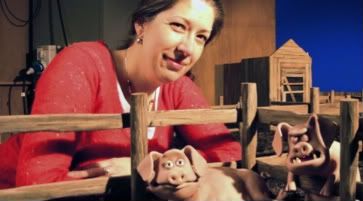
For many of us, animated films were the first films we watched. From the classic Disney films to television shows like “Family Guy” and “The Simpsons,” animation can follow us throughout our lives. However, the animation process remains a mystery to most of us.
Luckily, Portland animator Teresa Drilling kindly agreed to answer some of our questions about animation and the process in general. Her most recent project was the spectacular Christmas “Community” episode (see a clip at the end of this interview).
In the interview below, Teresa discusses what steps occur when working on an animated project, what exactly claymation is, and what’s next for her.
It’s Just Movies: How did you get started in animation?
Teresa Drilling: As a student at the Rochester Institute of Technology.
IJM: Can you describe the typical process for an animation project?
TM:For STOP MOTION projects you start with:
1. Write a script and develop a detailed storyboard and production design.
2. Determine production approach and processes, budget, equipment, software, cast, crew, schedule, marketing partnerships, distribution, publicity and funding.
3. Testing and pre-vis. Of everything, all at once and ongoing.
4. Record the voices, do character, armature, set, lighting and SFX design, construction and approach.
5. Animation, ongoing picture and sound editing, ongoing rewriting and development.
6. Post production sound, picture, effects. Promotion is ongoing.
7. Premier screening, submission to festivals and future distribution venues.
IJM:What are some of the changes you’ve seen in the stop motion animation process since you started working in the field?
TM:The animation process has not really changed at all. The addition of better and better pre-visualization and tracking tools has. It has improved vastly, and the cost of them has gone down drastically. Computer-assisted tools have reinvigorated and supported the stop motion medium tremendously. Also, there are more people coming in to professional jobs with better training.
IJM: It seems to me that stop motion claymation usually has a more adult audience than regular computer animation. Do you find that to be true and if so, do you think it allows you to do more on your projects?
TM:Claymation refers to a specific aesthetic style and process of work that was developed at Will Vinton Studios in the ’80s and ’90s. Nothing else is Claymation. Clay animation is any animation done with all or mostly all plasticine clay, like Gumby and early Aardman work. If there is no clay, then it is stop-motion animation, never Claymation (also called “model animation” in the UK).
Claymation is a type of clay animation AND stop motion animation. Clay animation is ALSO stop motion animation, but NOT necessarily Claymation. Stop motion animation CAN BE clay animation and/or Claymation, but NOT necessarily either.
I don’t find stop motion or CGI to be more child or adult centered than the other. There are examples of both in both mediums. Yes, there is more room for a wider variety of approaches with adult work, mostly because there are a lot of preconceived notions about what can be done for children that is limiting (and not necessarily true).
There is a tendency to make work for children that does not strive to develop intelligence by challenging with unfamiliar or advanced ideas. There is a tendency to make work for adolescents and young adults that encourages the cruder, sophomoric elements of those age groups rather than on the search for greater maturity and balance which is also an inherent urge in those age groups. The better projects do that, but don’t always get the support or patronage that allows them to be successful. Pixar has done a great job there on the CG side, and Aardman and LAIKA have done well there on the stop motion side.
IJM:What is your favorite animated work?
TM:That’s like asking what my favorite color is. It depends on the day, the light, and the context.
I liked “9” a lot, especially the original short, as well as “Mary and Max.” “Toy Story 3” was brilliant, also “How to Train Your Dragon,” “The Incredibles,” “Deadsy” by David Anderson, “The Wrong Trousers” by Nick Park, and ESPECIALLY Tim Hittle’s trilogy, “The Potato Hunter,” “Canhead,” and the newly-finished “The Quiet Life.”
IJM:What are you currently working on?
TM:I just finished animating part of a stop-motion spoof for “The Simpsons” that should be airing Feb. 20.
Currently, I’m teaching stop-motion animation classes at the Art Institute of Portland. We are finishing up AiPDs first student stop-motion short film project, which should be ready for it’s premier at the end of March/beginning of April.
IJM:Is there anything you’d like to add?
TM:I’m always on the lookout for new professional projects and collaborations. There is so much potential in stop-motion work, a lot of styles, stories and forms to explore. We truly have only scratched the surface of what is possible.
. . .
Follow Allison Higginbotham on Twitter at http://twitter.com/allisonbh.
That episode of “Community” was fantastic.
Great interview! I can’t believe she did the Christmas episode of Community! I LOVED that episode!